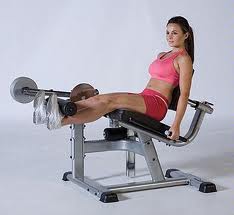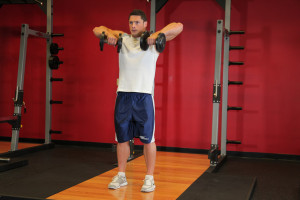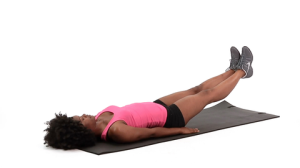Working out can be dangerous especially if you are a gym newcomer and you exercise without the guidance of a professional trainer. You could hurt yourself if you use the wrong strength training equipment or if you have the wrong form in exercising.
Consider the sit-up, which is one exercise you may think is totally safe. After all, you have seen countless of people do this in gyms like 24 Hour Fitness and Anytime Fitness, right? This exercise targets the obliques, lower and abdominal muscles.
In performing this work-out, your trainer has taught you to place your feet firmly on an abdominal board so that you can prevent yourself from sliding back. You then raise your shoulders near your feet, with the abdominal muscles being contracted during the movement. And then you slowly lower your shoulders again to complete one repetition.
But when done poorly, this exercise can overload the spine. It can also lead to back pain especially for the elderly. Studies also suggest that too much sit-ups can damage the spinal discs in the long run.
So how can you tell if an exercise is dangerous or risky? One of the foremost clues of a dangerous exercises is when it causes pain or discomfort. A risky exercise also causes unnatural movement pattern, and requires joint flexibility which is well beyond the range of motion of a part of a body. You can also categorize an exercise as dangerous when the risks of injury are far greater than the potential health benefit of the activity.
Aside from sit-ups, there are also other exercises that you should perform with caution such as:
Behind the Head Lateral Pull Downs
 This exercise, which requires you to pull a bar behind the neck, places a lot of stress on the joint of the shoulders. The bone of the upper arm, the humerus, is rotated outwardly which can destabilize the shoulder joint. The pulling movement also causes overstretched tendons and ligaments located on the frontal part of the shoulder. These could all lead to injury.
This exercise, which requires you to pull a bar behind the neck, places a lot of stress on the joint of the shoulders. The bone of the upper arm, the humerus, is rotated outwardly which can destabilize the shoulder joint. The pulling movement also causes overstretched tendons and ligaments located on the frontal part of the shoulder. These could all lead to injury.
If you have a desk job, then you should make this exercise the least of your priorities because you are likely to have poor posture due to the nature of your work. The lack of flexibility of your shoulder gets more complicated when you pull a heavy bar behind your neck, causing further misalignment.
An alternative would be to pull the bar down facing you, instead of behind your head. You should also keep your spine straight all the time when performing the exercise. And when you pull down the bar, it should be just near the chest level.
Seated Knee Extension
 The seated knee extension targets the quadriceps. The problem with this exercise is that it can do a lot of harm to the knees especially if the weights are too heavy. Likewise, our knees are not exactly designed to lift heavy weights even when fully extended. If you have had knee issues before, then you are putting a lot of pressure on your knees that may re-injure that part of the body. Specifically, this exercise can cause strained tendons and damage to the cartilage.
The seated knee extension targets the quadriceps. The problem with this exercise is that it can do a lot of harm to the knees especially if the weights are too heavy. Likewise, our knees are not exactly designed to lift heavy weights even when fully extended. If you have had knee issues before, then you are putting a lot of pressure on your knees that may re-injure that part of the body. Specifically, this exercise can cause strained tendons and damage to the cartilage.
The good news is that there are alternatives to this exercise. You can do a simple lunge with or without weights. Instead of using a knee lever machine, you can hold on to the wall or a chair to perform this exercise. You can thus focus more on your form.
Upright Rows
 The upright rows require you to lift two small barbells towards the bottom of your chin. But this can be very risky since the exercise can cause the humerus to collide with the acromion process joint. When this happens, the nerves in the shoulders could get compressed damaging the cartilage in the process and ultimately leading to arthritis.
The upright rows require you to lift two small barbells towards the bottom of your chin. But this can be very risky since the exercise can cause the humerus to collide with the acromion process joint. When this happens, the nerves in the shoulders could get compressed damaging the cartilage in the process and ultimately leading to arthritis.
Because the exercise targets the deltoids, you can also try an alternative like the bent-over rows. You can do this by bending your hips forward at a 90 degree angle. Hold the barbell down beneath the shoulders, then slowly lift it towards your chest area. There should be a straight line between the elbows and shoulders. Or you can do the lateral shoulder raise but this time you’ll be lifting a more manageable weight.
Leg Lifts
 The leg lift is a common move that yoga class participants perform. In this exercise, you lie on your back and lift your legs a few inches from the ground to target your abs. While it does work out the abdominal muscles, it can be damaging to the lower back. You can still do this exercise provided that you begin with the legs up in the air, and then slowly lower them without you feeling any discomfort in the back. You can also prevent injury to your lower back by doing other less risky alternatives like the standard bicycle crunch.
The leg lift is a common move that yoga class participants perform. In this exercise, you lie on your back and lift your legs a few inches from the ground to target your abs. While it does work out the abdominal muscles, it can be damaging to the lower back. You can still do this exercise provided that you begin with the legs up in the air, and then slowly lower them without you feeling any discomfort in the back. You can also prevent injury to your lower back by doing other less risky alternatives like the standard bicycle crunch.
